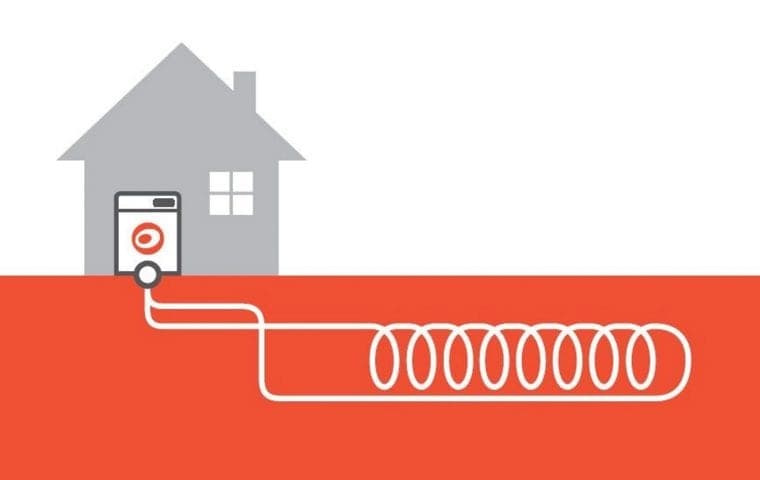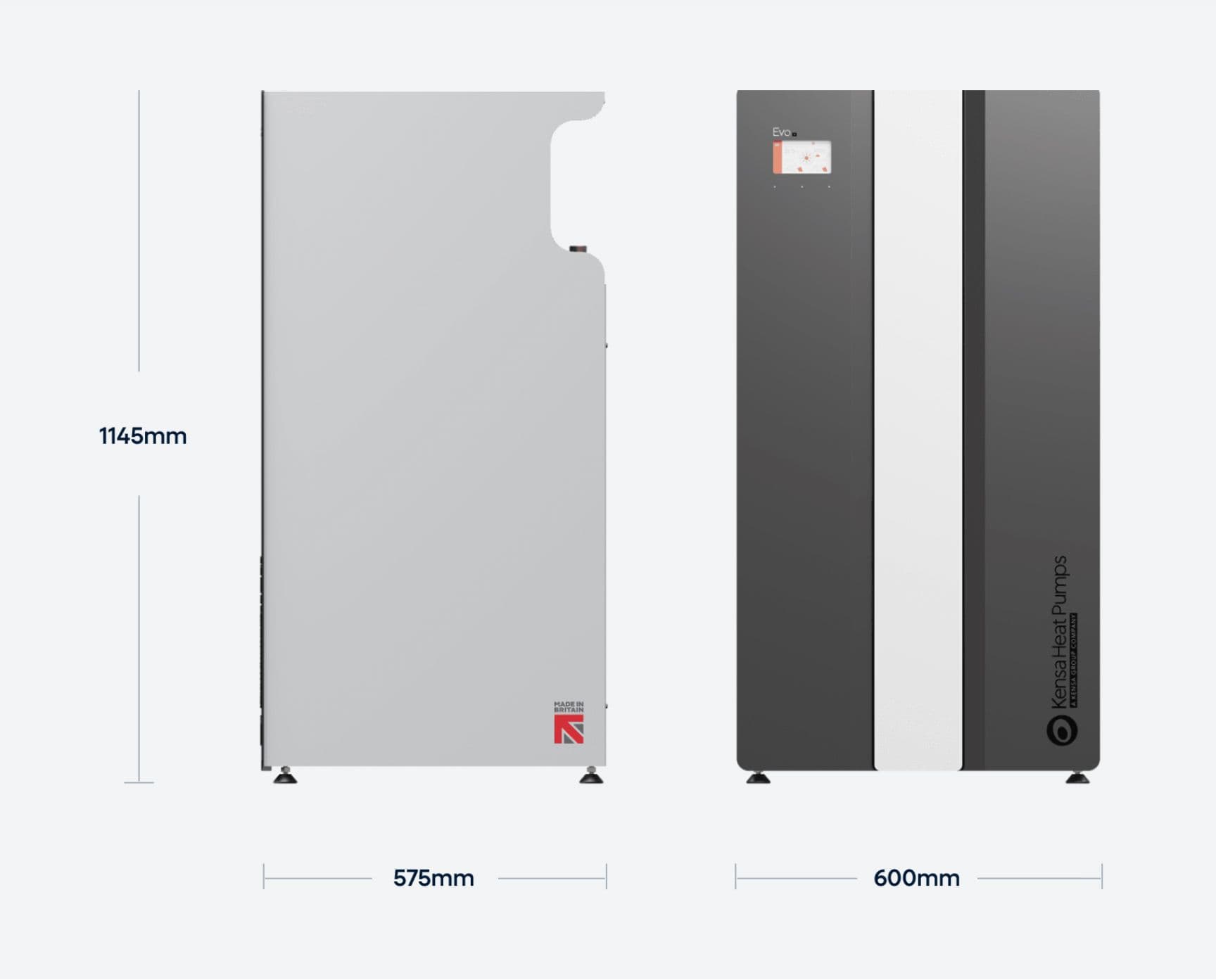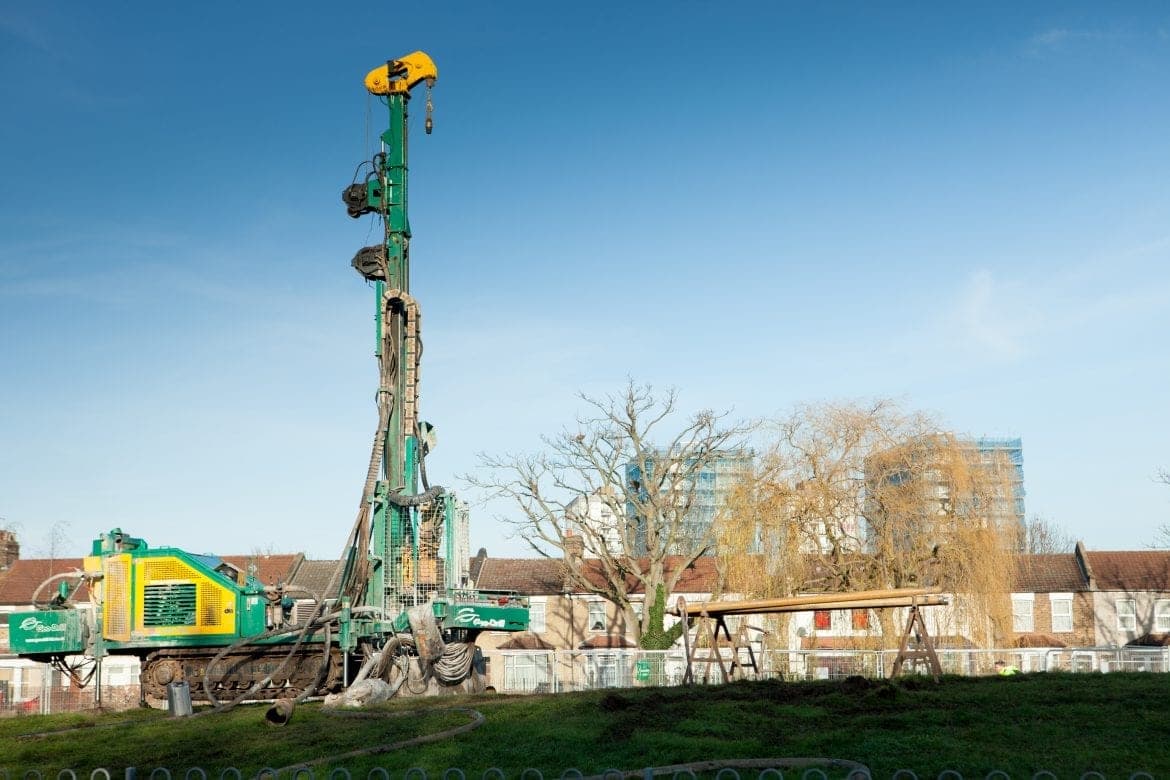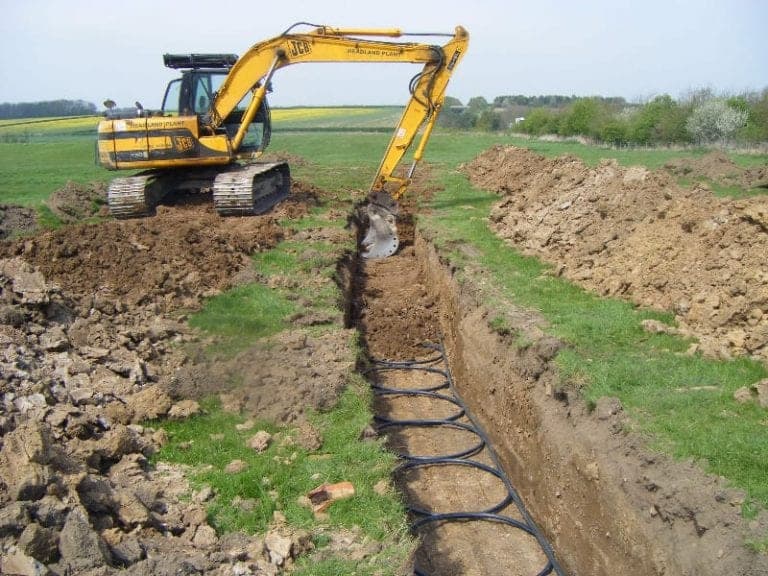A ground source heat pump can deliver 3 to 4 kilowatts (kW) of heat for every 1 kW of electricity it consumes.

What is the Efficiency of a Heat Pump?
Using freely available heat energy from the ground, it achieves higher efficiencies than any other heating system.
By delivering 3 to 4 times more heat energy than the consumed electricity to run the unit, a heat pump can reduce a property’s heating costs by around two-thirds compared to direct electric heating. Also efficient with times of electricity consumption, a ground source system is able to run when electricity is at its lowest cost or carbon.
What determines the efficiency of a heat pump installation?
The efficiency of a ground source heat pump installation can be influenced or improved by:
- The insulation of the property
- A well-designed system and installation
- The heat source that is used
- The heating distribution system and its size (radiators or underfloor heating)
The efficiency of a heat pump is implied by a measurement known as the Coefficient of Performance (CoP). This is the ratio between how much energy the heat pump produces and how much electrical energy it consumes. The Seasonal Coefficient of Performance (SCoP) is generally used as a year-round and realistic measurement – it’s based on CoP at different conditions and a standardised climate.
There is no set CoP for heat pumps, as they differ depending on many variables and testing conditions. However, when installed correctly, ground source heat pumps tend to achieve a high CoP.
How efficient is a heat pump compared to a boiler?
While modern condensing boilers can be over 90% efficient, a ground source heat pump can achieve efficiencies of 400%. The difference in efficiency is significant. That is because, unlike boilers, heat pumps deliver more energy than they consume – specifically from electricity. Find out more about gas boilers v's ground source heat pumps.
Can efficiency affect carbon emissions?
Efficient ground source heat pumps can deliver over 4kW of renewable energy for every 1kW of electrical energy they use. In turn, with more renewables such as solar and wind supplying the grid with power, there is potential to decarbonise the small portion of the electricity they consume.
Ground source heat pumps emit no point-of-use carbon emissions or air pollution, encouraging the UK’s transition to the mass electrification and decarbonisation of heat, and aiding the UK’s ambition to achieve net-zero carbon emissions by 2050.
Decarbonisation of the grid
Ground source heat pumps also offer efficiency in terms of load shifting and smart heating. Load shifting means the ground source heat pump can shift its consumption to the times of day when electricity is at its cheapest, and there is lower carbon. Battery storage, agile tariffs and smart controls make this possible.
No other technology can participate in load shifting like ground source heat pumps.
How does an efficient heat pump save me money?
A system that delivers much more electrical energy than it consumes will provide a household with the lowest running costs. This is because the less electricity required, the more likely the fuel costs will be lower for the household. It also means that the electricity production and distribution system has to deliver only a fraction of the energy required.
To offset the additional cost of installing a heat pump over a fossil-fueled system in domestic projects, there’s also the Boiler Upgrade Scheme. The government-funded Boiler Upgrade Scheme pays a flat-rate grant of £7,500 to those installing a ground source heat pump.
Explore different funding streams for different project types.
Making the most of dynamic tariffs
With their unique ability to participate in load shifting, ground source heat pumps can also save money by consuming power at the times when electricity is cheapest.

What is the most efficient ground source heat pump?
The Evo ground source heat pump
With an impressive A+++ rating in energy efficiency, the Kensa Evo is the most efficient ground source heat pump in our range.
The Evo’s intelligent touch-screen controls and sophisticated design add to its performance and appearance. It’s easy to keep track of efficiencies and features a world-first ground source controller – known as the Genesis System Manager – to ensure optimal system performance.
What makes a ground source heat pump system efficient?
Ground array design
To achieve the best efficiency for a ground source heat pump, a heat pump installer’s main focus should be on the design and commissioning of the attached systems – better known as ground arrays or heat collectors. You get the best possible energy efficiency from a ground source heat pump system when this is designed and installed well. Installers can use Kensa’s MCS Umbrella for complete design and installation support.Source & load temperatures
The two temperatures that the heat pump operates at will determine its efficiency. For both air and ground source units, we commonly call these temperatures the source, which is the temperature entering the heat pump, and the load, which is the temperature that leaves the heat pump for the property. The further apart the two temperatures are, the less efficient the heat pump will be. This is why ground source heat pumps operate most effectively with low-temperature heating distribution systems, which ensure comfort levels without compromising on efficiency’
How important is the efficiency of a heat pump?
It’s surprisingly easy to take one of the latest A+++ rated ground source heat pumps and get very poor efficiency from it. Equally, it’s possible to get very good results from an older design, less efficient unit by connecting it to a really good system.
The MCS SCoP rating – a year-round measurement for efficiency – should not be the sole indicator for what the most efficient system is or, therefore, what the most affordable system is. A good MCS SCoP rating does not necessarily mean the end-user is going to have the most efficient system with the lowest possible running costs.
To achieve this, we have outlined the steps installers can take to deliver the very best efficiencies with ground source heat pump systems.
Tips to improve heat pump efficiency
Insulate the building
For most system installations, improving efficiency means making changes to the building itself. This starts with insulation; heat is better contained inside an insulated building because its demand for energy is reduced.
With a conventional boiler, efficiency only improves to a certain extent with added insulation. The fuel burnt by the boiler will reduce in a fairly linear fashion as insulation is added.
However, with a heat pump, the electricity used will reduce by a greater amount. Not only is the quantity of heat required reduced, but energy can now be effectively delivered at a lower flow temperature – the temperature at which water travels through a radiator or underfloor heating. This improves the actual heat pump’s efficiency. It’s a double win for the heat pump, but only a single win for the boiler.
Any heating system – whether fossil-fuelled or renewable – can operate better in an insulated home, dispelling the myth that ground source heat pumps only suit well-insulated buildings.
Consider the heating distribution system
Heating distribution systems, such as underfloor heating and radiators can have an impact on the efficiency of a heat pump. For instance, underfloor heating works efficiently with a heat pump because larger surface areas are compatible with low flow temperatures. And the lower the temperature required of the heat pump, the less work it has to do to get there.
To put the importance of this into perspective, for approximately every 1°C decrease in the temperature leaving the heat pump, you save 2% on energy.
Bear in mind that there can be a difference in the temperature delivered from the heat pump, and its temperature by the time it reaches the heating distribution system. It’s important that these differences or losses are accounted for in design to achieve a building’s required temperature.
Kensa can give installers full support with designing, installing and commissioning.
Think twice before using buffer tanks
A buffer tank is an insulated vessel of water. Designed to keep a minimum amount of water in circuit when the heating load is low, its purpose is to prevent the heat pump from short cycling.
When well designed, most systems should operate well without the need for a buffer tank. However, when required, buffer tanks have been seen to cause a temperature reduction of 10°C across them, so the heat pump has to operate 10°C hotter than is actually necessary to heat the building. An installation like this can add 20% to the running costs, permanently, for no particular gain. This can affect efficiency, making the system work harder for a higher temperature.
The best option might be to use the water in the distribution pipes as the buffer, but bear in mind that this can be difficult to achieve, especially on retrofit installations.
Where a separate buffer tank is deemed necessary, it should only be connected with two pipes and should function as a bypass route rather than having full flow passing through it all the time. That way, it doesn’t cause any mixing and only gets any flow through it when needed.
See our buffer tank information for more details
Water pumps
Water pumps are responsible for moving the heat transfer fluid around the ground array, and moving the hot water into a property’s underfloor heating or radiators. Ironically, as the heat pump efficiencies improve, the proportion of energy used by the water pumps in the system takes up a greater proportion of electricity use. Fortunately, water pump manufacturers have been busy improving their products.
As a general rule, the total power of the hot water pump should not need to exceed about 1% of the thermal output – for example, a 100W water pump for a 10kW heat demand. On the ‘ground’ side of a heat pump, where the heat enters the unit from the ground, about 1.5% should be sufficient.
Kensa does not recommend multiple small water pumps dotted around a building. One correctly sized and controlled pump is almost always more efficient, and is also quieter. All pumps need to be correctly wired and controlled, as it is still common to find system pumps wired to a fused spur and left running permanently. Even a little 60W pump, if left running all year, will consume about £75 in electricity – it should be around £20 if correctly controlled with the heating system.
Avoid components that mix flow & return water
Any component on the heating system that allows warmer flow water to mix with cooler return water (without actually taking some useful heat from it in the process) is usually bad news for the efficiency of a heat pump system. The usual culprits are thermal stores, buffer tanks that have four connections in use and low loss headers that don’t have the flows balanced.
Choose the manifolds carefully
The next most common culprit in lowering system efficiencies are designs of underfloor heating manifolds that feature a thermostatic mixing valve and a pump. With one or two exceptions, these should be changed so they can’t act as a permanent bypass route. In general, thermostatic mixers aren’t ever required.
The only exception is where the underfloor is a screeded type and the system also has radiators on it. Without a thermostatic mixer, the radiators will probably never get warm enough. The choice of heat emitters is many and varied, it really doesn’t make any difference. The only question that always needs to be asked is “what’s the lowest water temperature it will still heat the building with?” The answer is the lower, the better!
Kensa can help installers get heat pump design and installation right.


How to make a heat pump & its source more efficient
With a ground source heat pump, the temperature reaching the heat pump is a function of the ground array design – also known as the ground collectors.
With a borehole system, design tends to determine efficiency. For example, oversizing the borehole can raise the source temperature, but can easily reach the point of negative returns. That said, the cost of extra drilling is never recouped in energy saving.
Horizontal ground arrays (slinkies) tend to be cheaper to scale up to allow for more energy absorption at relatively low groundwork costs. Assuming the land is available, putting in an extra circuit or two really doesn’t cost that much. It also partly future proofs the system if the building is ever extended and needs more heat.
Combining horizontal ground arrays with soakaways not only saves digging costs but can also lift the average temperature reaching the heat pump, again improving efficiency. Rain tends to come during slightly warmer periods of winter weather and the soakaways carry this warmer temperature into the ground – ready for harvesting by the heat pump.
Water source
Water is a great carrier of heat, making it the most efficient source for a heat pump. Open loop systems where the water comes from deep underground, such as aquifers or mine water, can yield high and consistent temperatures.
Care needs to be taken though. If the water is very deep below the surface, the energy used by any pump to lift it up can quickly exceed the energy saved because of the higher temperature. The usual point to start asking questions is any more than around 50 meters water lift.
Water source heat pumps are a great option for heating when next to a large body of water.
Measuring efficiency through Coefficient of Performance
What is Coefficient of Performance?
The Coefficient of Performance (CoP) demonstrates the efficiency of a technology. A ground source heat pump’s CoP is high because it uses free heat energy from the ground. The higher the CoP, the more efficient the technology. The CoP of a heat pump is calculated by dividing the amount of energy the system outputs by the amount of electricity that is put into the system.What is the Coefficient of Performance of a ground source heat pump?
For each kilowatt of electrical power supplied to run the ground source heat pump unit, around 4 kilowatts of heat energy is produced. This means the heat pump has a CoP of 3 to 5 compared to boilers, which typically have a CoP of less than 1. A high CoP of 3 to 5 means the end user benefits from significantly reduced carbon emissions and lower running costs. See our technical blog on maximising CoPCan the CoP of a heat pump vary?
The CoP varies depending on the temperature difference between the ground (inlet temperature) and the required temperature for the building’s underfloor heating or radiators (outlet temperature).How does ground temperature affect the CoP?
As the inlet temperature increases from the ground, the CoP will also increase. This is because the compressor inside the ground source heat pump doesn’t have to work as hard to reach the required output water temperature. The inlet temperature test condition that ground source heat pumps should be tested to determine the CoP is 0°C (as per European Standard EN14511). Although all heat pumps should be benchmark tested at 0°C inlet, in reality the ground temperature rarely falls this low and lowest source temperature of around 2°C to 4°C can be expected depending on the time of year. In terms of efficiency, this means that the testing conditions potentially underestimate the typical temperatures of the ground and therefore the CoP of a ground source unit. In comparison, air source heat pumps tend to overestimate typical testing conditions for measuring CoP. This is why it is always important to look at the conditions behind a heat pump’s CoP, to decipher if they are realistic.How does the heating distribution system temperature affect the CoP?
The higher the outlet temperature of the heat pump (the heating distribution system i.e. radiators or underfloor heating), the more work the compressor inside the heat pump has to do to achieve a building’s required temperature. This will lower the CoP of a heat pump. This is why heat pumps are ideally suited to underfloor heating mounted in screed, which typically only requires a low inlet temperature of under 35°C. Using radiators may result in a lower CoP due to the higher flow temperatures they require.